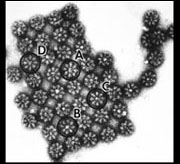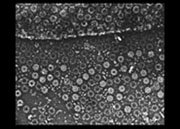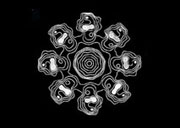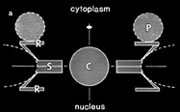Nuclear pore complex
The nuclear pore complex is an organelle, ubiquitous to eukaryotic cells, which serves as a pathway though the nuclear envelope for nuclear and cytoplasmic molecules. It is present in high concentrations in the nuclear envelopes of Xenopus oocytes, which are readily isolated, enabling analysis of its architecture by three-dimensional electron microscopy and selective release experiments. The nuclear pore was shown to be an assembly of several discrete components arranged with octagonal symmetry. Apparent two-fold axes perpendicular to the octad axis suggest that the framework is built from two equal but oppositely facing halves. The half facing the cytoplasm is in some instances decorated by large particles similar in appearance and size to ribosomes.
Key publication:
Unwin, P.N.T. and Milligan, R.A. A large particle associated with the perimeter of the nuclear pore complex. J. Cell Biol. 93, 63-75 (1982). (pdf)




